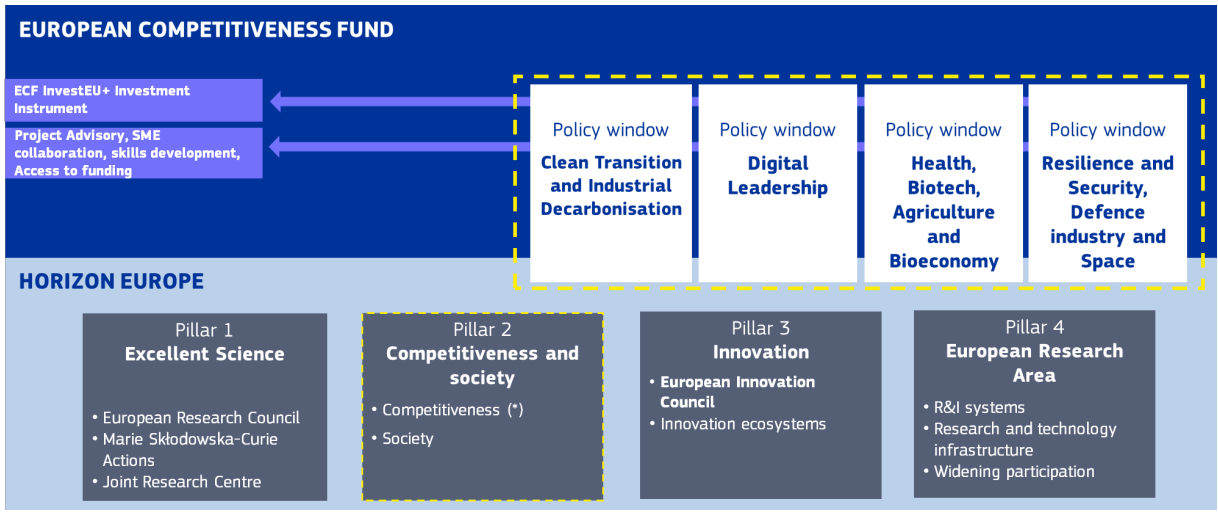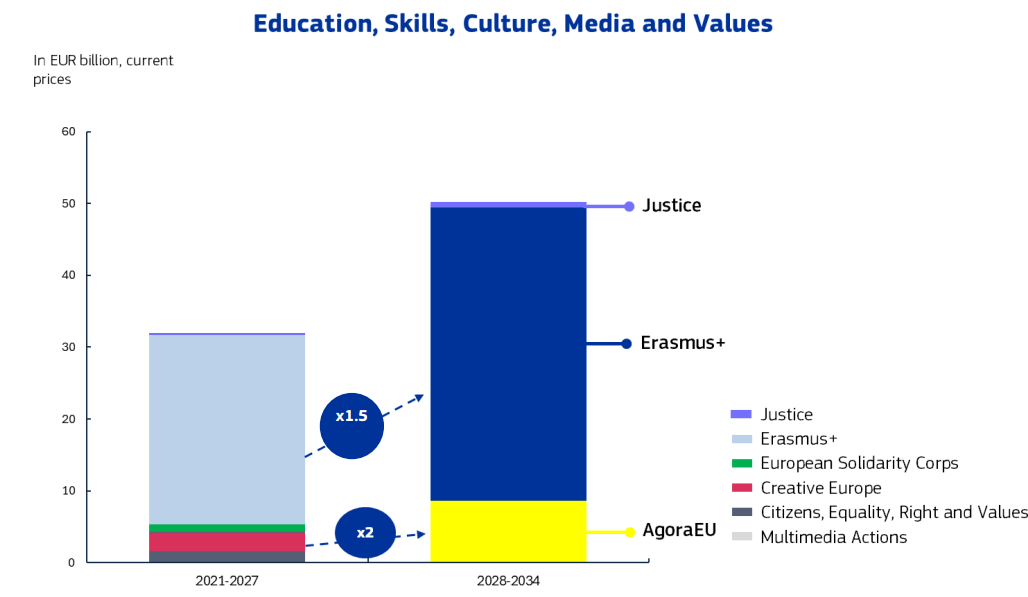New Horizon to double budget, Erasmus+ to increase by 50%
On Wednesday 16 July, the President of the European Commission presented the budget for 2028-2034, which amounts to €2 trillion.
On Wednesday 16 July, the President of the European Commission Ursula von der Leyen presented the long-awaited budget proposal for the upcoming Multiannual Financial Framework 2028-2034 at a press conference. The draft budget, which must be approved by both the EU Council and the European Parliament, is set at just under two trillion euros. The main arguments and points used by the President to present the budget were:
- the need to invest in people,
- strengthening the EU's competitiveness, defence and resilience,
- a stronger position of Europe in the world,
- greater flexibility across the budget so that Europe can act and react quickly when needed,
- simpler, more streamlined and harmonised EU financial programmes for easier access to funding.
In particular, references to competitiveness and investing in people are the key areas of focus for us, as these are reflected in the proposals for the budgets of Horizon Europe (linked to Competitiveness Fund) and Erasmus+.
- Horizon Europe budget proposal (2028-2034): €175 billion
- Erasmus+ budget proposal (2028-2034): €40.8 billion
Before any speculation, please note that anything in the proposal, including the amounts, the shape of the instruments, but also the pillar structure, may change during the upcoming two-year negotiations, which will now involve Member State representatives and Members of the European Parliament.
The Competitiveness Fund and the new Horizon Europe
To put this in context, during 2025 we reported on the evolution of the debates on the so-called FP10 (10th Framework Programme for Research and Innovation) and its possible link to the Competitiveness Fund. Related to this were concerns about cutting Pillar II of the Framework Programme, reducing funding for collaborative projects and prioritising innovation at the expense of basic research, or the complete abolition of widening instruments. Maintaining the independence of the ERC Council was also a major concern. There was also fear in the research community about the SSH (social sciences and humanities) or the European Institute of Innovation and Technology (EIT), which was not mentioned at all in the leaked proposal from early July.
However, the current proposal seems to have somewhat calmed down the science, research and innovation community. Although the Framework Programme is integrated into the structure of the Competitiveness Fund, it has its own budget, almost twice as large. The pillar structure and the original division into excellent science, collaborative projects, innovation and the more general fourth pillar, which covers the European Research Area, research and technological infrastructures and the widening instrument, have also been retained.
 (Figure 1)
(Figure 1)
One of the uncertainties remains the form of the link between the Competitiveness Fund and the new Framework Programme. The biggest intersection is in the second collaborative pillar (with an allocation of €75.9 billion). In it, we can find a total of four destinations (see Figure 1), collectively labelled Competitiveness. The Competitiveness Fund has the same so-called Policy Windows (see Figure 2). In these areas, the Fund is to have a common work programme with Horizon, but with a clearly defined area for competitiveness on its own and an area for research and innovation.
 (Figure 2)
(Figure 2)
Another question mark in the link between the Competitiveness Fund and FP10 is the so-called Moonshots. These projects would move rapidly from research to demonstration activities and practical application. For this type of project, as described on the European Commission's website, funds are to be raised from both instruments and, at the same time, from national, public and private sources. Moonshots are to focus on a variety of topics, such as quantum computers, clean water or the space economy.
The European Innovation Council (EIC) will continue to be a central instrument for promoting breakthrough technologies and innovation, and is foreseen to be strengthened in the FP10 proposal. Compared to the current period, when the EIC has around €10 billion at its disposal, the proposal foresees a significant increase in the financial allocation of up to €40 billion under the third pillar of the FP10. As already proposed in the Draghi report, the EIC should also include elements of ARPA (risky projects) and DARPA (support for start-ups working in defence or dual-use technologies).
The first pillar of the Framework Programme, Excellent Science, is to receive €44.1 billion under the draft budget, a significant increase on the current period. Concerns that have resonated among the research community in recent months have focused on the European Research Council (ERC) and the Marie Skłodowska-Curie Actions (MSCA) programme, with some experts warning that these instruments could be partially subsumed under the Competitiveness Fund, which could undermine their autonomy and excellence. However, the current proposal has allayed these concerns. Both the ERC and the MSCA are to remain fully autonomous, without any link to the mechanisms of the Competitiveness Fund. Moreover, the increased budget sends a clear signal that basic research and international mobility of researchers remain at the heart of European investment in science.
In previous weeks, there was concern in the academic community that the social sciences and humanities (SSH) would be left out of the new Framework Programme proposal or not given the weight they deserve. However, according to recent information, SSH are to become a horizontal priority of the whole Framework Programme - i.e. they will not only be part of selected thematic clusters, but will link across all pillars and call types. This approach is intended to ensure deeper interdisciplinary cooperation and stronger involvement of SSH in addressing technological, climate and geopolitical challenges. Yet, the question remains as to how such engagement will be implemented in practice - i.e. whether SSH will actually be structurally and meaningfully integrated into the challenges.
As part of the transition to FP10, there are also plans to significantly increase the use of lump sums, which are already widely used in Horizon Europe. This instrument brings in particular simpler budgeting, less administrative burden and lower audit error rates. On the other hand, it raises significant concerns about the use of this type of funding for larger, collaborative projects with many partners. The European Parliament, led by ITRE, points out that the impact of lump sums on the quality of management and results of these challenging initiatives is not yet clear. Their widespread application will certainly be a point of contention, especially with the European Parliament.
What are the plans to invest in education, democracy and European values?
Erasmus+
Erasmus+ will remain a separate programme, but the previously independent European Solidarity Corps, which supports volunteering, will become part of it. The European Commission plans to increase the budget of the expanded Erasmus+ programme by 50% in the next programming period, from the current €26 billion to €40.8 billion. This increase in funding is intended to contribute to a resilient, competitive and cohesive Europe by promoting high-quality lifelong learning, improving skills and competences for life and jobs for all, while promoting Union values, democratic and civic participation, solidarity, social inclusion and equal opportunities in the EU and beyond.
Erasmus+ should continue to promote high quality education and training, increasing the learning mobility of young people to develop skills and create shared experiences. By investing in youth, volunteering and sport, Erasmus+ will help build a stronger and more connected society, foster civic and democratic engagement and contribute to social cohesion at all levels. The new Erasmus+ programme will be a key instrument for addressing structural, horizontal, sectoral and cross-border skills challenges in the EU. It will support the priorities set by the Union of Skills, focusing on the long-term development of skills linked to competitiveness, thereby strengthening the resilience of the EU labour market.
Previous fears circulating in the international education community have been refuted by the Commission's proposal. Concerns were expressed, for example, about limiting Erasmus+ to mobility projects only, or the transfer of excellent initiatives such as the European University Alliances or the Centres of Vocational Excellence (CoVE) outside Erasmus+, for example to the Competitiveness Fund. The draft regulation establishing Erasmus+ for the period 2028-2034 shows that the new Erasmus+ is to have a slightly different structure, but cooperation projects and support for policy reforms, as well as the European University Alliances and CoVE, remain part of it.
Instead of key actions, the new programme should be divided into two pillars:
-
Learning opportunities for all
-
Support for capacity building
The first pillar should include learning mobility projects at all levels of education, including non-formal education (youth, sport and adult education). It should also include volunteering projects, including humanitarian aid volunteering, and opportunities to develop talent and excellence: Erasmus+ scholarships in strategic educational areas, including joint degree programmes, Erasmus Mundus scholarships and Jean Monnet actions in higher education.
The second pillar is designed to promote cooperation between organisations and institutions and will therefore include collaborative partnerships, but also partnerships for excellence and innovation (European University Alliances, Centres of Vocational Excellence, European Teacher Academies, European School Alliances, Joint study programmes, European Youth Together and Sport Collaborative Alliances). The second pillar is also to include support for policy development, including actions which are known as Key Action 3 in the current programme.
The draft Regulation also states that there are strong links between Erasmus+ and the European Competitiveness Fund and synergies are needed to help overcome silos between education, research and innovation and the labour market (and to some extent non-formal and informal learning), which would ultimately lead to a stronger EU competitiveness.
New AgoraEU programme
In its multiannual budget proposal, the European Commission plans to create a new AgoraEU programme, which would include the current Creative Europe programme promoting artistic freedom, media pluralism and democratic principles and the Citizens, Equality, Rights and Values (CERV) programme.

Initial reactions to the European Commission proposal
Immediately after the press conference, MEPs who are Parliament's rapporteurs for the Multiannual Financial Framework and for own resources, including MEP Danuša Nerudová, described the draft budget as insufficient. In a joint statement, they point to a fundamental flaw in the Commission's plan: with a budget of just 1.26% of gross national income (GNI), which includes 0.11% of GNI for debt repayments from the NextGenerationEU instrument, and taking inflation into account, the EU will stagnate. They argue that this budget proposal leaves insufficient funds for key priorities such as competitiveness, cohesion, agriculture, defence, adaptation to climate change and the investments necessary for a sustainable economy for all. The European Parliament has also previously expressed concerns about the proposed structure of the long-term budget, warning that moving successful programmes into 'umbrella mega-funds' could jeopardise proven policies that have delivered concrete results and improved living standards. However, in a statement, the rapporteurs on own resources welcome the Commission's new efforts on own resources and the presentation of other options for new sources of revenue for the EU budget.
Christian Ehler, a member of the ITRE committee and an MEP who has shaped several previous framework programmes from the European Parliament, assessed the proposal positively but warned against a certain amount of caution. He is referring here to the link between the Competitiveness Fund and Horizon Europe, because the proposal provisionally assumes too much freedom for the Fund, which could become a blank cheque for sticking any problems of the Union and thus affect the envelope of Horizon Europe itself.
More information on the draft budget, including legal documents, can be found on the European Commission's website.